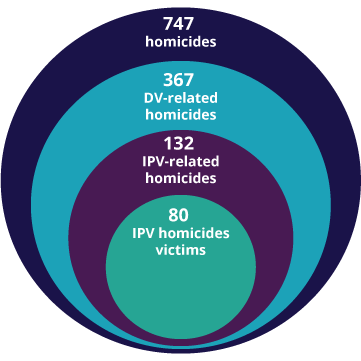Intimate partner/domestic violence
"Please realize that these things DO happen. You may think to yourself 'oh that will never be me' and then suddenly you find yourself in a bad relationship, and a scary situation."
Domestic violence is violence that occurs in a domestic (or household) setting, such as in a family or among people who live together. Intimate partner violence (IPV) is a subset of domestic violence. IPV is abuse that occurs between people in a romantic relationship. Intimate partner refers to both current and former spouses and dating partners. IPV contains four types of behavior:
- Physical abuse is when a person hurts or tries to hurt a partner by hitting, kicking, burning, or using other physical force.
- Sexual abuse is forcing a partner to take part in a sex act when the partner does not consent.
- Threats of physical or sexual abuse include the use of words, gestures, weapons, or other means to communicate the intent to cause harm.
- Emotional abuse is threatening a partner or his or her possessions or loved ones, or harming a partner’s sense of self-worth. Examples are stalking, name-calling, intimidation, or not letting a partner see friends and family.
If you or someone you love is in a violent relationship, call these FREE hotlines open 24 hours a day/7 days a week.
Utah Domestic Violence Link Line
1-800-897-LINK (5465)
Rape & Sexual Assault Crisis Line
1-888-421-1100
1-800-897-LINK (5465)
1-888-421-1100
Utah statistics
- In 2022, 14.2% of adults reported having ever been physically hurt by an intimate partner, with 1 in 5 female adults reporting it.1
- In 2023, Utah had the second-lowest homicide rate in the United States.2 Even with this comparatively low rate, every life lost to homicide is a profound tragedy. Domestic and intimate partner violence remains a serious issue in Utah and is a major factor in many of these deaths.
- Almost 1 in 3 female homicide victims died from a current or former spouse or girlfriend/boyfriend.3*
- In Utah, nearly half of homicides are related to domestic violence.3*
- Exposure to domestic violence is an Adverse Childhood Experience (ACES).
IPV and DV-related homicide deaths, Utah, 2014–2023

See the data
*The definition for domestic violence and intimate partner violence homicide is based on the victim to suspect relationship collected in the National Violent Death Reporting System. For intimate partner violence victims, that includes current or former spouse or girlfriend/boyfriend. For domestic violence victims, that also includes a parent, child, sibling, grandchild, grandparent, in-law, stepparent, stepchild, child of suspect’s boyfriend/girlfriend, intimate partner of suspect’s parent, foster child, foster parent, other family member (e.g., cousin, uncle, etc.), and roommate.
Teen dating violence data
In 2023, among Utah teens who were dating or going out with someone:
- More than one in five (23.1%) students were verbally or emotionally harmed by someone they were dating or going out with one or more times during the past 12 months. 4
- More than one out of every 12 students was forced by someone they were dating or going out with to do sexual things they did not want to do during the past 12 months.4
- More than one out of every 15 students were physically hurt on purpose by someone they were dating or going out with one or more times during the past 12 months.4
Ways to prevent relationship violence
- Learn and demonstrate healthy relationship behaviors.
- Increase effective communication skills.
- Develop healthy conflict resolution skills.
- Support income equality policies.
- Become connected with your community.
- Seek social support.
What are the warning signs that someone is in a violent relationship?
Survivors
- Sudden changes in appearance.
- Avoids contact with family and friends.
- Spends all of their free time with the abuser.
- Cries a lot; moody.
- Is very stressed with physical symptoms.
- Sudden changes in behavior.
- Defends the abuser and their actions.
Abusers
- Sudden and drastic mood swings.
- Acts macho or cocky.
- Jealous and controlling.
- Cruelty to animals and/or children.
- History of battering.
- Constantly checking on their partner.
- Blames others for his/her problems.
What can you do if you’re in a violent dating relationship?
- Decide that any abuse is too much.
- Tell someone you are being abused.
- Document your injuries.
- Call a local hotline for help.
- Fill out a personalized safety plan.
- Remember that it is NOT your fault you are being abused.
How can you help a loved one who is in a violent dating relationship?
- Learn all you can about abuse.
- Teach your loved one about abuse.
- Document the injuries you see.
- Call a local hotline for more resources.
- Listen to your loved one.
- Be patient!
References
- Utah Department of Health and Human Services, Office of Public Health Assessment, Behavioral Risk Factor Surveillance System (BRFSS), 2022 data queried via Utah’s Indicator-Based Information System for Public Health (IBIS-PH) [cited 2025 August]
- Centers for Disease Control and Prevention (CDC), Web-based injury Statistics Query and Reporting System (WISQARS), 2023 data [cited 2025 August].
- Utah Violent Death Reporting System, Violence and Injury Prevention Program, Utah Department of Health and Human Services, 2014–2023 data [cited 2025 August].
- Utah Youth Risk Behavior Surveillance System, Utah State Office of Education, 2023 data queried via Utah’s Indicator-Based Information System for Public Health (IBIS-PH) [cited 2025 August].